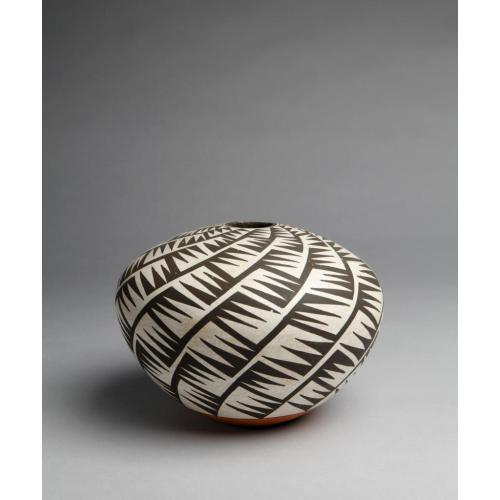
Photograph by Addison Doty. Copyright 2015 School for Advanced Research.
Seed jar
Date: 1959
Artist or Maker: Lucy Martin Lewis (1898 - 1992)
Dimensions:
Dimensions: 14.9 × 20.3 cm (5 7/8 × 8 in.)
Weight: 0.7 kg (1.65 lb.)
Medium: clay | paints
Credit Line: Indian Arts Fund purchase for the permanent collection, 1959.
Place Made:
Valencia County, New Mexico, Southwest, United States, North America
Object Number: IAF.2780
Not on view
Tribal Collection Review RemarksAccording to the participants in the Acoma collection review visit June 26-27, 2017 (Events Record “Collection Review: Acoma Pueblo Review 9”): Dolores Lewis Garcia mentioned that her mother, Lucy, liked to revive old Chaco style designs. Not much more was said about this seed jar.
According to the participants in the Acoma collection review visit February 26-27, 2019 (Events Record “Collection Review: Acoma Pueblo Review 12”): Seed jars are used for storing items like seeds, vegetables, and fruits, or smaller items such as beans, plants and pine nuts. They were often sealed to preserve what they were storing. Seed jar forms are still being made and used today at Acoma. They are characterized by having a flatter shoulder area coming to a circular opening at the center. Like all forms being produced today, they are produced and painted with both traditional natural and commercial materials. Older seed jar forms tend to have a lower half that looks similar to a water jar or bowl shape. More recent seed jar forms tend to be spherical or saucer like in shape and medium to small in size.
In Collection(s)
Bibliography:
Acoma and Laguna Pottery
- Pg. p. 107, 228
- Fig. 5.20
The Indian Arts Research Center, in collaboration with Native American community scholars, strives to present accurate collections records. Records may be updated as new information becomes available and is reviewed with the Native American community having cultural affinity to particular items. Please write to iarc@sarsf.org if you have questions or concerns related to the documentation.
